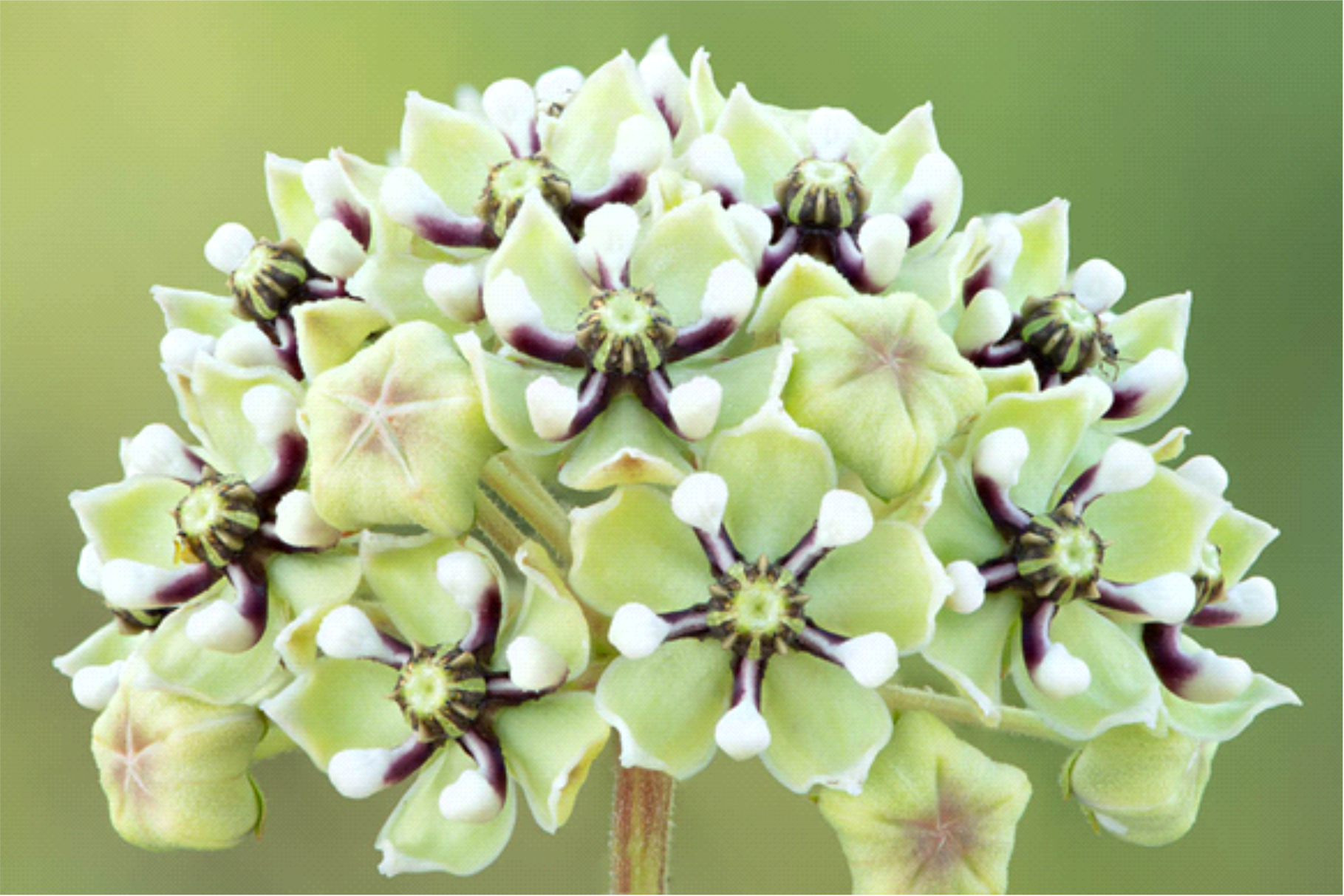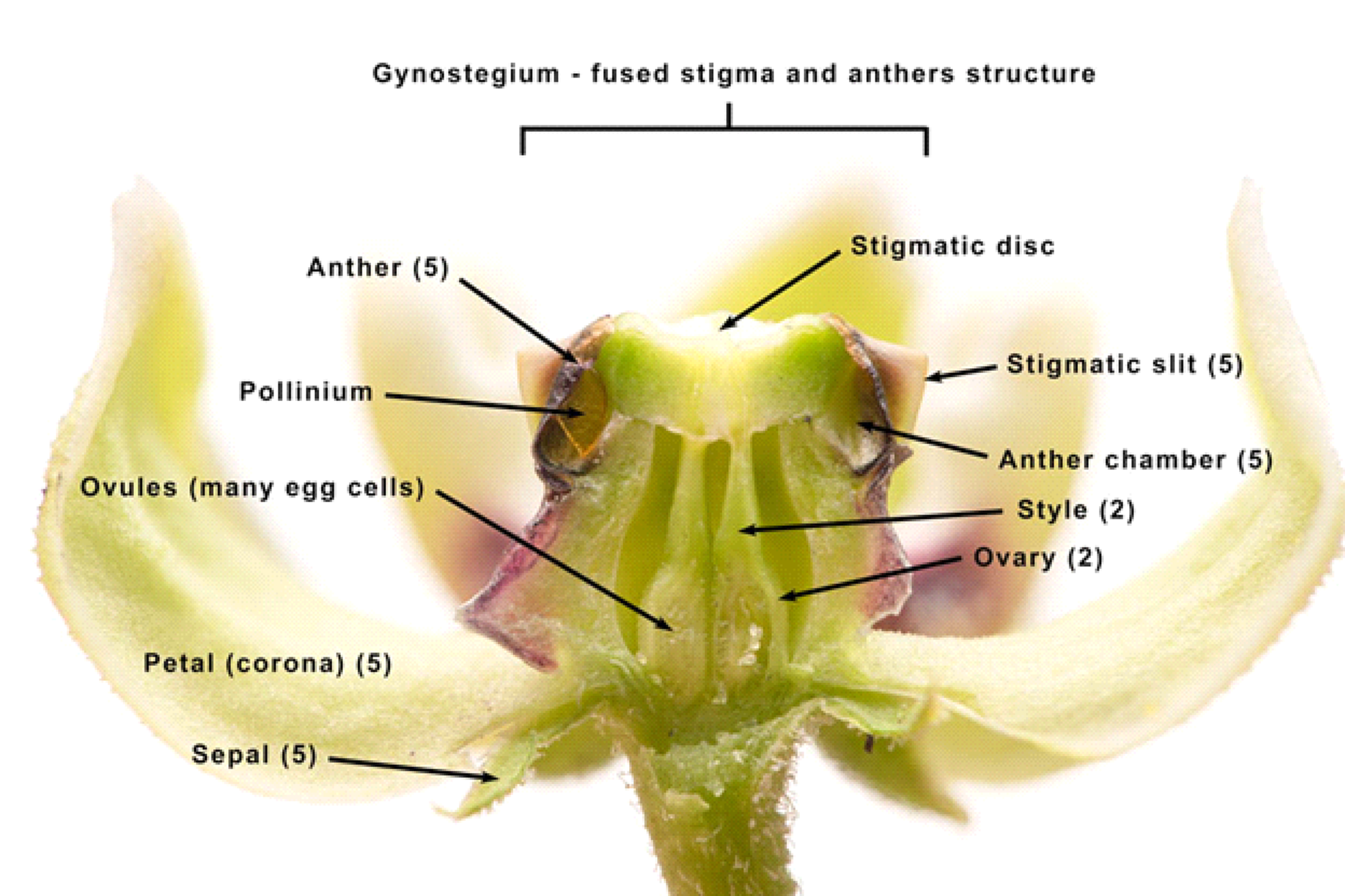Asclepias Asperula on:
[Wikipedia]
[Google]
[Amazon]
''Asclepias asperula'', commonly called antelope horns milkweed or spider milkweed, is a


 The central circular structure is a gynostegium, the fusion of 2 stigma and 5 anthers. Antelope horns do not have individual pollen grains. The pollen sticks together as granular masses contained on a pollinarium structure located within each of the 5 stigmatic chambers. The pollinarium is made up of 2 pollinium “wings” connected to a central corpusculum via 2 translator arms. The picture "Antelope horns pollinarium" shows a pollinarium that was pulled out of the stigmatic slit using an insect pin.
The central circular structure is a gynostegium, the fusion of 2 stigma and 5 anthers. Antelope horns do not have individual pollen grains. The pollen sticks together as granular masses contained on a pollinarium structure located within each of the 5 stigmatic chambers. The pollinarium is made up of 2 pollinium “wings” connected to a central corpusculum via 2 translator arms. The picture "Antelope horns pollinarium" shows a pollinarium that was pulled out of the stigmatic slit using an insect pin.



Image:Asclepias_asperula_6.jpg, Subspecies ''A. a. asperula''
Image:Asclepias_asperula.jpg, Subspecies ''A. a. capricornu''
Native Plant Information Network
* * * * * *
species
In biology, a species is the basic unit of classification and a taxonomic rank of an organism, as well as a unit of biodiversity. A species is often defined as the largest group of organisms in which any two individuals of the appropriate s ...
of milkweed
''Asclepias'' is a genus of herbaceous, perennial, flowering plants known as milkweeds, named for their latex, a milky substance containing cardiac glycosides termed cardenolides, exuded where cells are damaged. Most species are toxic to humans ...
native to the Southwestern United States
The Southwestern United States, also known as the American Southwest or simply the Southwest, is a geographic and cultural region of the United States that generally includes Arizona, New Mexico, and adjacent portions of California, Colorado, Ne ...
and northern Mexico
Mexico (Spanish: México), officially the United Mexican States, is a country in the southern portion of North America. It is bordered to the north by the United States; to the south and west by the Pacific Ocean; to the southeast by Guatema ...
.
Description
It is aperennial plant
A perennial plant or simply perennial is a plant that lives more than two years. The term ('' per-'' + '' -ennial'', "through the years") is often used to differentiate a plant from shorter-lived annuals and biennials. The term is also wide ...
growing to 0.3–0.9 m (1–3 ft) tall, with clustered greenish-yellow flower
A flower, sometimes known as a bloom or blossom, is the reproductive structure found in flowering plants (plants of the division Angiospermae). The biological function of a flower is to facilitate reproduction, usually by providing a mechani ...
s with maroon highlights. It blooms from April through June.
Antelope horns is a common milkweed in Central Texas. It gets its name from the follicles (seed pods) that resemble the horns of antelope. You can easily spot the flower clusters (technically, umbellate cymes) in open meadows. Milkweed plants are a major food source for Monarch and Queen butterfly caterpillars and as with other milkweed plants, it bleeds white latex if a stem is cut and this sap is toxic to some animals and to humans. It also makes Monarch and Queen butterflies taste bad to potential predators, a nice defense mechanism. From a distance the flowers appear as tennis-sized spheres, but they are clusters of small green, purple, and white flowers. Each flower has 5 pale green petals that cup upward around 5 prominent white hoods (which store nectar).

Flower Structure and Pollination

 The central circular structure is a gynostegium, the fusion of 2 stigma and 5 anthers. Antelope horns do not have individual pollen grains. The pollen sticks together as granular masses contained on a pollinarium structure located within each of the 5 stigmatic chambers. The pollinarium is made up of 2 pollinium “wings” connected to a central corpusculum via 2 translator arms. The picture "Antelope horns pollinarium" shows a pollinarium that was pulled out of the stigmatic slit using an insect pin.
The central circular structure is a gynostegium, the fusion of 2 stigma and 5 anthers. Antelope horns do not have individual pollen grains. The pollen sticks together as granular masses contained on a pollinarium structure located within each of the 5 stigmatic chambers. The pollinarium is made up of 2 pollinium “wings” connected to a central corpusculum via 2 translator arms. The picture "Antelope horns pollinarium" shows a pollinarium that was pulled out of the stigmatic slit using an insect pin.


Antelope Horns Pollination
Pollination of Antelope Horns happens when flowers are visited by insects that get their reward in nectar (in this case primarily sucrose) which is accessible at the base of each of the hoods. Several different types of insects visit milkweed searching for nectar including bees, butterflies, moths, flies and beetles. As they move around the flower in search of nectar one of their legs may slip into a stigmatic slit. The only way to safely remove their leg is to move it upwards toward the top of the slit. The leg can then snag on the corpusculum and pull out the entire pollinarium. When the insect visits another milkweed flower carrying this pollinarium, there is a chance a pollinium would slip into an empty stigmatic slit, dislodge, and remain there. If the orientation of the pollinium is correct and the concentration of nectar surrounding a pollinium is optimal, pollination will take place. Pollen tubes grow out of a germination pore on the convex surface of the pollen mass on pollinium into the stigma and down one of the 2 styles to the ovary where the male genetic material fertilizes the (female) ovules. Each ovule has the potential to form one seed. The image "Antelope Horns pollen tube" shows the route pollen tubes take to transfer genetic material into an ovary. ''Asclepias asperula'' does not self-pollinate so they are dependent on attracting pollinators that will transfer pollen between plants.
Taxonomy
''Asclepias asperula'' is divided into two subspecies: ''A. asperula. ssp. asperula'' and ''A. asperula ssp. capricornu''. Ssp. capricornu occurs in comparatively more mesic conditions and has comparatively broader leaves, floral crowns that are more white, and a more prostrate habit. Ssp. asperula occurs in comparatively more arid conditions and has comparatively narrower leaves, floral crowns that are more purple, and a more upright habit.Ecology
Like several other species of milkweed, ''A. asperula'' is a food for monarch butterfly caterpillars. Along with being food for monarchs, the plants also contain toxic cardiac glycosides (cardenolide
A cardenolide is a type of steroid. Many plants contain derivatives, collectively known as cardenolides, including many in the form of cardenolide glycosides (cardenolides that contain structural groups derived from sugars). Cardenolide glycoside ...
s) that the monarchs retain, making them unpalatable and poisonous to predators. For the same reason, ''A. asperula'' can be poisonous to livestock and other animals, including humans.
In addition to the monarch, it is a larval host to the dogbane tiger moth
''Cycnia tenera'', the dogbane tiger moth or delicate cycnia, is a moth in the family Erebidae. It occurs throughout North America, from southern British Columbia to Nova Scotia southwards to Arizona and Florida. The species is distasteful and th ...
, the queen butterfly
The queen butterfly (''Danaus gilippus'') is a North and South American butterfly in the family Nymphalidae with a wingspan of . It is orange or brown with black wing borders and small white forewing spots on its dorsal wing surface, and reddish ...
, and the unexpected cycnia
''Cycnia inopinatus'', the unexpected cycnia, is a moth of the family Erebidae. It was described by Henry Edwards in 1882. It is found in the United States (Florida, Arkansas, Georgia, Illinois, Indiana, Iowa, Kansas, Kentucky, Maryland, Massachu ...
.
Cultivation
The plant is difficult to cultivate and does not grow well in containers. In cultivation, this species favors quickly draining soil that is high in inorganic matter, such as sand and rock chips. It can grow in loam and clay, if provided with adequate drainage and frequent dryness. Moisture level demands and tolerance depend upon the subspecies and possiblyecotype
In evolutionary ecology, an ecotype,Greek: ''οίκος'' = home and ''τύπος'' = type, coined by Göte Turesson in 1922 sometimes called ecospecies, describes a genetically distinct geographic variety, population, or race within a species, ...
. The plant has a deep taproot, so it needs to have the deepest-possible pot if grown in a container and should not be waterlogged.
References
Further reading
* * *External links
Native Plant Information Network
* * * * * *
asperula
''Asperula'', commonly known as woodruff, is a genus of flowering plants in the family Rubiaceae. It contains 194 species and has a wide distribution area from Europe, northern Africa, temperate and subtropical Asia to Australasia.
Species
* ' ...
Butterfly food plants
Flora of the Southwestern United States
Flora of Northwestern Mexico
Flora of Sonora
{{Apocynaceae-stub